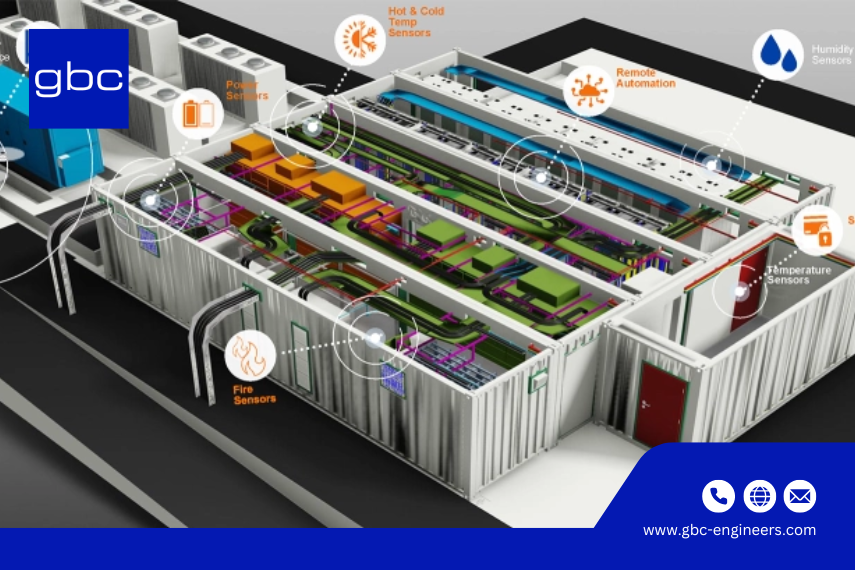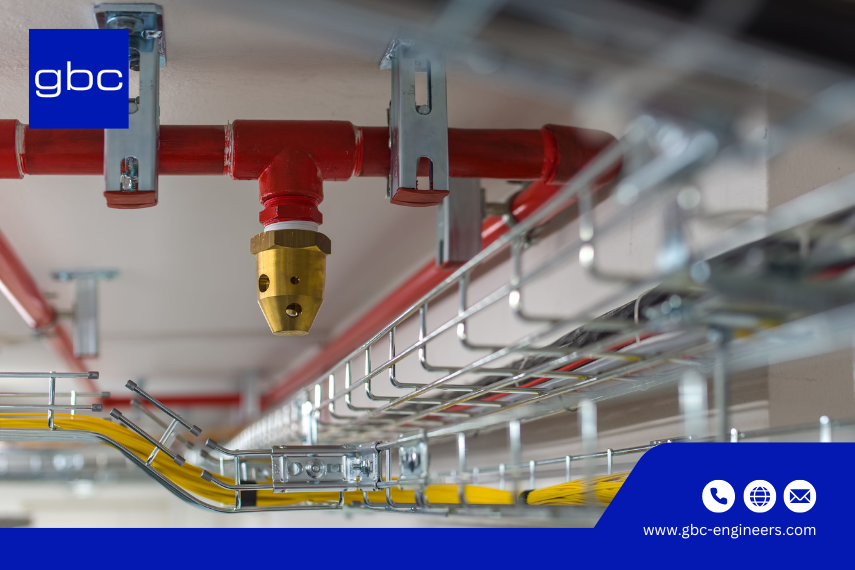A well-structured data center layout is essential to ensure the stable and continuous operation of IT infrastructure 24/7. Whether in the early-stage design or the ongoing operational phase, data centers revolve around two key questions:
What are the core components of a data center?
What physical infrastructure is required in a data center facility?
Let’s explore how a typical data center layout is organized and what each section contributes to overall performance and reliability with gbc engineers.
Key Zones in a Data Center
A standard data center layout is strategically organized into three main zones:
- Server Room
- Power Room
- Network Operations Center (NOC)
Each area plays a critical role in ensuring 24/7 uptime, security, and high performance. Let’s explore the layout and what lies inside a data center.
1. Server Room (Computer Room)
The Server Room is the heart of the data center, housing critical IT equipment such as servers, storage systems, and networking devices. This area is climate-controlled and equipped with advanced security features to prevent unauthorized access.
This includes:
- Servers – for computing and local storage
- Routers & Switches – for internal and external network connectivity
- Firewalls – for data protection and access control
- Storage Systems – for secure data retention
- Application Delivery Controllers – for optimizing application performance
In a modern data environment, the server room plays a vital role in supporting both dedicated and colocation infrastructure models. These core components enable essential functions such as data storage, processing, and connectivity—driving digital efficiency for businesses and service providers alike.
Explore our blog to learn how innovative solutions are transforming server room operations and powering the next generation of data centers.
2. Power Room
The Power Room manages the data center infrastructure's power supply, ensuring efficient and reliable power distribution. This includes:
- Uninterruptible Power Supplies (UPS)
- Power Distribution Units (PDUs)
- Backup Generators
- Electrical Panels and Switchgear
These systems are engineered to maintain stable, uninterrupted energy—even during outages or voltage fluctuations—making them essential for uptime and operational continuity.
As part of a resilient data center infrastructure, the Power Room ensures that mission-critical systems receive the power they need, when they need it. To explore more on sustainable power solutions and best practices, check out our latest blog posts.
We are committed to transparency and responsible data management—learn more in our privacy policy.
3. Network Operations Center (NOC)
The Network Operations Center (NOC) is a centralized location where IT professionals monitor and manage the data center's network, servers, and storage equipment. The NOC is responsible for ensuring system availability, performance, and security—especially in high density environments where rapid response is critical.
NOC Features:
- Video walls and monitoring dashboards
- Alert management systems
- Help desk functions
- Security systems integration
- Remote access controls
In modern data centers, NOCs play a key role in optimizing energy consumption, detecting anomalies, and maintaining compliance with operational standards. As the nerve center of operations, the NOC ensures everything runs smoothly—from routine maintenance to incident response.

Contact Us Now: Kontakt - gbc engineers
What Are the Core Components of a Data Center?
A data center comprises several critical components that work together to support digital operations:
1. Computing Resources
Servers provide the processing power, memory, and local storage necessary for running applications and services. They are the engines that drive a data center's operations.
2. Networking Equipment
Networking devices like routers, switches, and firewalls form the backbone of the data center, facilitating data flow and ensuring secure connectivity.
3. Storage Systems
Data centers utilize various storage technologies, including Storage Area Networks (SANs), Network Attached Storage (NAS), and Direct Attached Storage (DAS), to store and manage data.
4. Infrastructure and Environmental Controls
Beyond IT equipment, data centers require robust infrastructure to maintain optimal operating conditions. This infrastructure is meticulously designed to meet compliance standards and industry regulations—ensuring that intellectual property, client data, and all operational systems are protected under strict policies where rights are reserved and upheld.
5. Power Infrastructure
Components like UPS systems, backup generators, and PDUs deliver stable and reliable power to data center equipment.
6. Cooling Systems
Cooling systems, such as Computer Room Air Conditioning (CRAC) units and hot/cold aisle containment, maintain optimal temperature and humidity levels to prevent equipment overheating.
7. Fire Suppression Systems
Data centers are equipped with sophisticated fire suppression systems, including gas-based systems like FM-200 or Novec 1230, to protect sensitive equipment without causing water damage.

Layout Optimization Best Practices
Designing an efficient data center layout includes:
- Hot/Cold Aisle Arrangement: Reduces cooling loads by separating hot and cold airflows.
- Rack Elevation Planning: Considers weight, power draw, and airflow per rack.
- Redundancy and Fault Tolerance: Design with N+1 or 2N configurations for critical systems.
- Scalability: Ensure space, power, and cooling capacity for future growth.
Ready to Future-Proof Your Data Center?
Partner with gbc engineers to design a facility that delivers performance, reliability, and long-term value.
🌐 Visit:
www.gbc-engineers.com
🏗️ Explore Our Services:
Services - gbc engineers
Conclusion
Understanding the data center layout—from the Server Room to the Power Room and NOC—is key to building efficient, secure, and future-ready infrastructure. At gbc engineers, we support smart data center design that meets the evolving needs of cloud technology and business continuity.
Whether you're exploring our products, reading this blog, or searching for trusted partners, we value your time and goals. Explore our careers page or search our services to learn how we can support your next data-driven project.